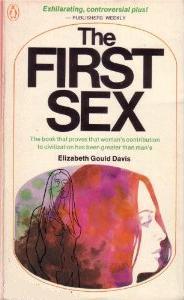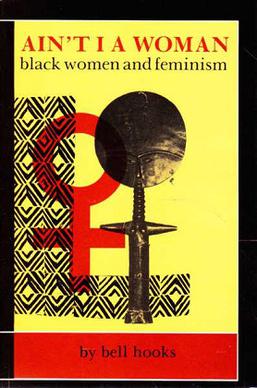
Ain't I a Woman? Black Women and Feminism is a 1981 book by bell hooks titled after Sojourner Truth's "Ain't I a Woman?" speech. hooks examines the effect of racism and sexism on black women, the civil rights movement, and feminist movements from suffrage to the 1970s. She argues that the convergence of sexism and racism during slavery contributed to black women having the lowest status and worst conditions of any group in American society. White female abolitionists and suffragists were often more comfortable with black male abolitionists such as Frederick Douglass, while southern segregationalists and stereotypes of Black female promiscuity and immorality caused protests whenever black women spoke. Hooks points out that these white female reformers were more concerned with white morality than the conditions these morals caused black Americans.
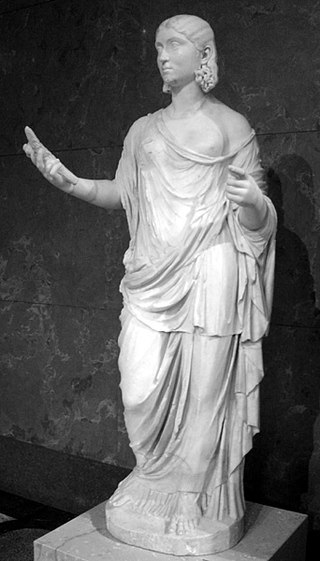
Thealogy views divine matters through feminine perspectives including but not limited to feminism. Valerie Saiving, Isaac Bonewits (1976) and Naomi Goldenberg (1979) introduced the concept as a neologism. Its use then widened to mean all feminine ideas of the sacred, which Charlotte Caron usefully explained in 1993: "reflection on the divine in feminine or feminist terms". By 1996, when Melissa Raphael published Thealogy and Embodiment, the term was well established.

Matriarchy is a social system in which positions of dominance and privilege are held by women. In a broader sense it can also extend to moral authority, social privilege, and control of property. While those definitions apply in general English, definitions specific to anthropology and feminism differ in some respects.

When God Was a Woman is the U.S. title of a 1976 book by sculptor and art historian Merlin Stone. It was published earlier in the United Kingdom as The Paradise Papers: The Suppression of Women's Rites. It has been translated into French as Quand Dieu était femme in 1978, into Dutch as Eens was God als Vrouw belichaamd – De onderdrukking van de riten van de vrouw in 1979, into German as Als Gott eine Frau war in 1989 and into Italian as Quando Dio era una donna in 2011.

A mother goddess is a major goddess characterized as a mother or progenitor, either as an embodiment of motherhood and fertility or fulfilling the cosmological role of a creator- and/or destroyer-figure, typically associated the Earth, sky, and/or the life-giving bounties thereof in a maternal relation with humanity or other gods. When equated in this lattermost function with the earth or the natural world, such goddesses are sometimes referred to as the Mother Earth or Earth Mother, deity in various animistic or pantheistic religions. The earth goddess is archetypally the wife or feminine counterpart of the Sky Father or Father Heaven, particularly in theologies derived from the Proto-Indo-European sphere. In some polytheistic cultures, such as the Ancient Egyptian religion which narrates the cosmic egg myth, the sky is instead seen as the Heavenly Mother or Sky Mother as in Nut and Hathor, and the earth god is regarded as the male, paternal, and terrestrial partner, as in Osiris or Geb who hatched out of the maternal cosmic egg.
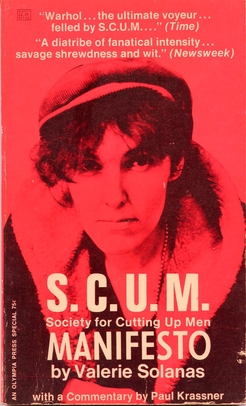
SCUM Manifesto is a radical feminist manifesto by Valerie Solanas, published in 1967. It argues that men have ruined the world, and that it is up to women to fix it. To achieve this goal, it suggests the formation of SCUM, an organization dedicated to overthrowing society and eliminating the male sex. The SCUM Manifesto has been described as a satire or parody, especially due to its parallels with Freud's theory of femininity, though this has been disputed, even by Solanas herself.
The Triple Goddess is a deity or deity archetype revered in many Neopagan religious and spiritual traditions. In common Neopagan usage, the Triple Goddess is viewed as a triunity of three distinct aspects or figures united in one being. These three figures are often described as the Maiden, the Mother, and the Crone, each of which symbolizes both a separate stage in the female life cycle and a phase of the Moon, and often rules one of the realms of heavens, earth, and underworld. In various forms of Wicca, her masculine consort is the Horned God.
Equality feminism is a subset of the overall feminism movement and more specifically of the liberal feminist tradition that focuses on the basic similarities between men and women, and whose ultimate goal is the equality of both genders in all domains. This includes economic and political equality, equal access within the workplace, freedom from oppressive gender stereotyping, and an androgynous worldview.
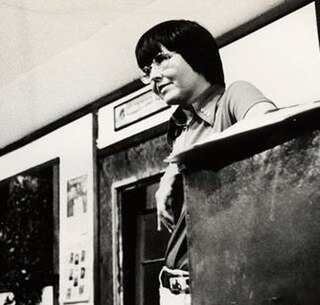
Mary Daly was an American radical feminist philosopher and theologian. Daly, who described herself as a "radical lesbian feminist", taught at the Jesuit-run Boston College for 33 years. Once a practicing Roman Catholic, she had disavowed Christianity by the early 1970s. Daly retired from Boston College in 1999, after violating university policy by refusing to allow male students in her advanced women's studies classes. She allowed male students in her introductory class and privately tutored those who wanted to take advanced classes.
Androcracy is a form of government in which the government rulers are male. The males, especially fathers, have the central roles of political leadership, moral authority, and control of property. It is also sometimes called a phallocracy or andrarchy or an androcentric or phallocratic society.

The Goddess movement is a revivalistic Neopagan religious movement which includes spiritual beliefs and practices that emerged primarily in the United States in the late 1960s and predominantly in the Western world during the 1970s. The movement grew as a reaction both against Abrahamic religions, which exclusively have gods who are referred to using masculine grammatical articles and pronouns, and secularism. It revolves around Goddess worship and the veneration for the divine feminine, and may include a focus on women or on one or more understandings of gender or femininity.

Woman's Evolution: From Matriarchal Clan to Patriarchal Family is a 1975 book by the American revolutionary socialist Evelyn Reed. The book gives a Marxist view on the history of women and is considered to be a pioneer work of Marxist feminism. It has been translated into many languages.

Elizabeth Gould Davis was an American librarian who wrote a feminist book called The First Sex.

The Myth of Matriarchal Prehistory: Why An Invented Past Will Not Give Women a Future is a 2000 book by Cynthia Eller that seeks to deconstruct the theory of a prehistoric matriarchy. This hypothesis, she says, developed in 19th century scholarship and was taken up by 1970s second-wave feminism following Marija Gimbutas. Eller, a retired professor of religious studies at Claremont Graduate University, argues in the book that this theory is mistaken and its continued defence is harmful to the feminist agenda.

A matriarchal religion is a religion that emphasizes a goddess or multiple goddesses as central figures of worship and spiritual authority. The term is most often used to refer to theories of prehistoric matriarchal religions that were proposed by scholars such as Johann Jakob Bachofen, Jane Ellen Harrison, and Marija Gimbutas, and later popularized by second-wave feminism. These scholars speculated that early human societies may have been organized around female deities and matrilineal social structures. In the 20th century, a movement to revive these practices resulted in the Goddess movement.
Patriarchy is a social system in which positions of authority are primarily held by men. The term patriarchy is used both in anthropology to describe a family or clan controlled by the father or eldest male or group of males, and in feminist theory to describe a broader social structure in which men as a group dominate society.
Feminism is one theory of the political, economic, and social equality of the sexes, even though many feminist movements and ideologies differ on exactly which claims and strategies are vital and justifiable to achieve equality.
Barbara Mor was an American poet, editor, and Feminist of the twentieth-century Goddess movement. She became most widely known for The Great Cosmic Mother, a cross-disciplinary study that cites numerous archaeological, anthropological, historical and mythological texts and artifacts as evidence of women's role as creators and first practitioners of humanity's earliest religious and cultural belief systems. She was published by Athena Press, WomanSpirit, Second Porcupine Press, Harper & Row, and The Oliver Arts & Open Press. Her poetry was included in Fired Up with You : Poems of a Niagara Vision, edited by the poet Will inman

The Chalice and The Blade: Our History, Our Future is a 1987 book by Riane Eisler. The author presents a conceptual framework for studying social systems with particular attention to how a society constructs roles and relations between the female and male halves of humanity.

A large amount of research on prehistory has been dedicated to the role of women in pre-literary society. Tasks typically undertaken by women are thought to have formed a major sexual division of labor in relation to child-rearing, gathering, and other everyday occupations. More recent research has however suggested women also played an active role in hunting and other physical activities in place of the exclusively domestic roles traditionally occupied by women in literary civilizations.
